 |
| > Deutsch > Contact |
Content
Ay-O
Rainbow Installation in Paris: Japan
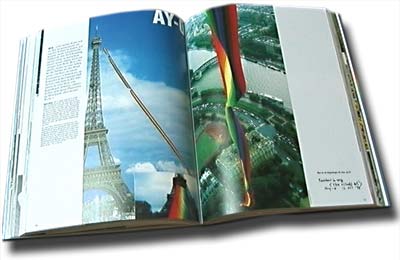
«The aim of my artwork is to find the starting point in my own body. I started perceiving my work as an artist as a kind of discovery of my senses. This approach led me to the «Finger-Arm-Body-Box» (touching), on to a piece of work where perfume squirts out of a wall (smelling), then a culinary event (tasting), concerts in Carnegie Hall (hearing), and then in the Sixties to a series involving rainbows (seeing). Since then my work has been centred around this phenomenon.»
Alberto Ruz Buenfil
Master of Ceremony in the networked age, Initiator of the Rainbow Caravan in North, Central & South America
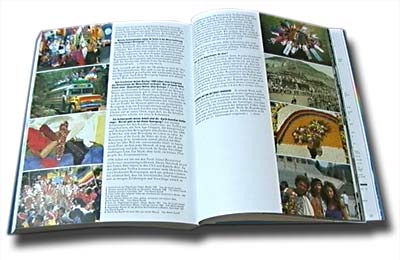
As a 50-year-old, Alberto begins one more journey: Since 1996, the Rainbow Caravan has been leading an international group of people from the USA through Central America to South America. On their journey the «caravanistas» - so far 70 from 15 countries - have met the Maya, the Lenka, Cacaopera, Nahuatl, Bribri, Chorotega, the Kuna, Wayuu and Yukpa. By means of their exchange they created friendships, brought suggestions, hope and inspiration. They took in these peoples' messages, songs, dances and stories, integrated them in their art work and passed them on to other people. On its way through Mexico, Central and South America, the Caravan has organised hundreds of public performances on squares, in churches and in prisons, in cultural centres and schools, at universities and embassies. The participants held audiovisual events, courses and sweat hut ceremonies, took part in carnival processions and peace walks and initiated television and radio programs.
«Over the last years, I realised how important it is to pass on our experiences and our knowledge to the following generation. Everywhere we go, we visit the schools, trying to inspire the pupils!»
«Ecological villages are an important movement today. All of these projects exchange ideas on a national basis. We are now trying to create international links. We want to find out, which of these projects are promising to be successful, in order to start establishing funds to finance them. Many original rainbow movements and communities have grown into the form of ecological villages. They will be an important form of living this millennium.»
Maralam
Peter Braschler - Intercultural Theatre, Switzerland
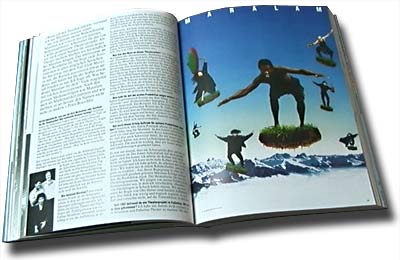
«How did Maralam come into being? It all started at the school of performing arts with a small project, for which we were supposed to bring our own experiences to bear. I staged a small play with refugees. Accidentally, a Caritas employee was present at the performance. He suggested, we repeat it in other places. More in jest, I said: Four weeks later he called me, only to promise us 50,000 Swiss francs. I had never thought this was possible!
I returned to the refugee centre, where I was still working on weekends, to look for talented «actors». So I met Anton Ponrajah, a Tamil with whom I still work today. He was regarded as a black sheep in the camp. With him and other lay actors, Swiss and Tamil, the first production emerged. In 1985, this was totally unknown to the public.
We had «advanced knowledge», experience in meeting «strangers», that most people did not have yet. By the means of drama we could convey this knowledge to the public. We initiated a kind of confrontation. The positive reactions to this form of intercultural drama were led by Peter Meyer's very positive review in the Tages Anzeiger. Within two days, 25 performances sold out. I think, in this year we had the largest media coverage of all theatre groups in Switzerland. It was as if the media would prompt each other to write more stories about our project.»
José Argüelles
Myth of Quetzalcoatl - Maya calender - Time is Art, USA
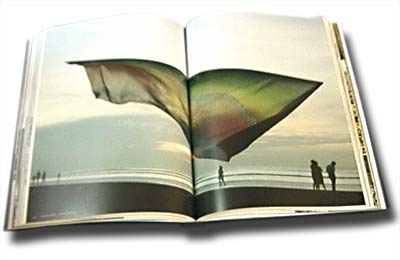
Among humanity's myths there is almost certainly not a second one to anticipate the development of human history, as does the myth of Quetzalcoatl, the feathered rainbowsnake.
The symbolic figure of Quetzalcoatl and its colour coding are based on a figure found on a side wall of a pyramid temple at Xochicalco in Mexico. Quetzalcoatl has a double meaning: On the one hand, he is recorded in history as a teacher and cultural messenger walking through Central America. On the other hand, Quetzalcoatl stands for a mythical understanding of human history as a whole.
The name Quetzalcoatl consists of three parts: The word «Quetzal» means valuable green, bird or feather, «co» is the generic term for snake and the word «atl» means water. Thus the name as a whole means: The feathers of the bird, the creature that lives in the highest element, are linked to the body of the water snake, a creature of the lowest element. The name stands for fulfilment: the highest and the lowest united in one body.
The historical figure of Quetzalcoatl lived in various incarnations nearly a thousand years after the birth of Christ in Central America, teaching on his journeys through the country. To the Incas in South America he was known as Viracocha, under the name of Itzamnà he is said to be the founder of Maya culture, the Maya of Yucatan called him Kukulcan, and to the Guatemalan Maya he was Gugumatz. Today he is known to us mainly under his Aztec name. «Feathered snake» was a title attributed to the great teacher in a similar way as «Christ» - «Lord's Anointed» - was attributed to Joshua Bar Joseph, the Jewish carpenter or «Buddha» - «enlightened one» - to Siddharta Gautama, the young Hindu prince.
From tree house to house tree:
The Auerworldpalast, Marcel Kalberer & Soft Structures, Germany
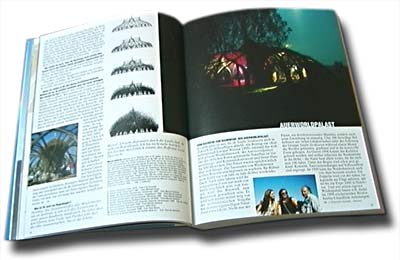
As a contribution to «Weimar – European Cultural Capital 1999» the world's largest construction made of willows was built: the Auerworldpalast. The natural construction made from bundled, locally grown switches is a venue for events and communication, housing up to 800 people. And the palace is growing: The thousands of willow switches develop roots and start growing. Their leaves make the roof more covered every year. After some years, the original form will only be visible from inside: from the outside the construction will have grown into a «house tree». The Auerworldpalast will continue to overcome its architectural origin, creating its own natural form.
Not only the palace, a three-dimensional mandala, but also its construction is unique. Over a month, more than 300 volunteers from many countries were tying the willow bundles, planting them and bending them into the special shape according to the Soft Structures group's instructions. Easter 1998, the topping-out ceremony could take place. Concerts, dance events, full moon festivals… have been planned. Starting in 1999, the willow construction can also be admired from the air. For Expo 2000 a zeppelin will offer flights from the near-by station. Those who would like to build their own willow palace can find practical instructions in the «Weidenbaubuch» (willow-construction book).
More information about Marcel Kalberer & Sanfte Strukturen
Positive News
Creative diversity & sustainable economic activity, England
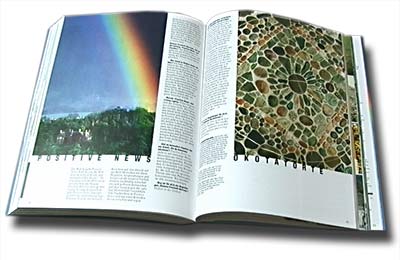
Positive News is a magazine, published four times a year, featuring articles on innovative and lively projects all over the world. The magazine includes the periodical Living Lightly.
«Positive News is able to link people of the most different backgrounds, professions and age groups in a unique way. There are for example extensive networks concentrating on a specific topic or a philosophy. We would like to join them all. Living Lightly consists in the following: the serene life on earth, not to take oneself too seriously, to live life with elegant simplicity, to recognise beauty and set it free, to discharge ballast and discover the spirit inherent in all things.» Shauna Crockett-Burrows, editor
East meets West
Vajra Hotel in Kathmandu, Nepal
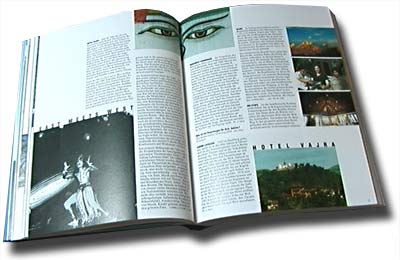
Since 1980, tourists, artists, photographers, writers, journalists, film-makers, development workers, scientists, Hindu scholars, Buddhist nuns and monks, diplomats, politicians, environmentalists and civil rights campaigners from Nepal and from all over the world have been meeting at the Vajra Hotel under the motto «East meets West». Many guests stay at the hotel for a longer period of time in order to work on their own projects. The Hotel built in a typical Nepali and Tibetan style is situated near the Swayambhunath stupas and designed to further communication. As it turned out, the concept is working. Part of the attraction are the guests themselves. Ecological requirements have been taken into account without compromise from the very start of the project.
Apart from its quiet surroundings, a garden looked after with care and roof terraces offering beautiful views, the Vajra offers a wide range of activities as a cultural centre: the Explorer restaurant, a meeting point offering a wide choice of native and Asian dishes, a bar serving Nepali drinks only, Ayurvedic massage, an art gallery with changing exhibitions, Studio 7, an international theatre group belonging to the hotel, an institute for classical and Nepali dance. Various cultural events take place on the roof terraces or in an artfully designed room above the roofs of Kathmandu. At the hotel there is also the Ecotechnics Research Library, including standard Tibetan and Sanskrit texts as well as specialised books in European languages. Swami Dharmjyoti, who temporarily also lives at the Vajra, is the librarian.
More information about Vajra Hotel
Spiert Aviert
European Youth Forum, Switzerland
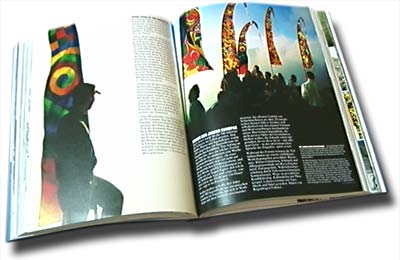
Spiert Aviert - European Youth Forum - was initiated for the 700-year anniversary of the Swiss Confederation. Since then every three years three hundred young people from European countries meet in the Engadine valley to deal with at a specific aspect of the future. In various workshops the young people, who do not want to be passive victims of what is happening, can take part in shaping the future before it has arrived - in an open spirit, spiert aviert, as they say in Rumantch the language of the Engadine valley.
The forum participants have a large choice of workshops: racism, changing climate, making jewellery and everyday things out of recycling material, European policy, training of one's perception by video recordings, solar energy, ways of solving conflicts without violence, cultural drama, creating visions of life using dance, music and play, painting Rainbow Flags…
The Rainbow Flags are painted by all participants as a group project. The leaders of the workshop, Thomas Bertschi and Paul Christ, encourage the young people to realise their own idea or event using flag painting as a starting point and a visual element of attraction - be this a cultural event, a street party, a citizens' initiative or an intercultural meeting. Twenty flags travel with participants to their home countries. They are taken to Bosnia, Croatia, Poland, Russia, Slovenia, Turkey, Hungary, Usbekistan, Italy, Slovakia, USA, Costa Rica and to Esslingen in Switzerland…
